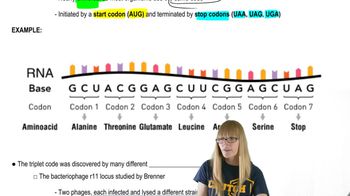Why do you think discoveries in genetics have been recognized with so many Nobel Prizes?
Table of contents
- 1. Introduction to Genetics51m
- 2. Mendel's Laws of Inheritance3h 37m
- 3. Extensions to Mendelian Inheritance2h 41m
- 4. Genetic Mapping and Linkage2h 28m
- 5. Genetics of Bacteria and Viruses1h 21m
- 6. Chromosomal Variation1h 48m
- 7. DNA and Chromosome Structure56m
- 8. DNA Replication1h 10m
- 9. Mitosis and Meiosis1h 34m
- 10. Transcription1h 0m
- 11. Translation58m
- 12. Gene Regulation in Prokaryotes1h 19m
- 13. Gene Regulation in Eukaryotes44m
- 14. Genetic Control of Development44m
- 15. Genomes and Genomics1h 50m
- 16. Transposable Elements47m
- 17. Mutation, Repair, and Recombination1h 6m
- 18. Molecular Genetic Tools19m
- 19. Cancer Genetics29m
- 20. Quantitative Genetics1h 26m
- 21. Population Genetics50m
- 22. Evolutionary Genetics29m
1. Introduction to Genetics
Fundamentals of Genetics
Problem 20b
Textbook Question
The following segment of DNA is the template strand transcribed into mRNA:
5'-...GACATGGAA...-3'
What is the amino acid sequence produced by translation?
 Verified step by step guidance
Verified step by step guidance1
Identify the direction of the template strand. The template strand is given as 5'-...GACATGGAA...-3'. Remember that transcription produces an mRNA strand complementary to the template strand, and the mRNA is synthesized in the 5' to 3' direction.
Determine the complementary mRNA sequence. Use base-pairing rules: A pairs with U (in RNA), T pairs with A, G pairs with C, and C pairs with G. Write the mRNA sequence in the 5' to 3' direction.
Divide the mRNA sequence into codons. Codons are groups of three nucleotides that correspond to specific amino acids. Start from the 5' end of the mRNA sequence and group the nucleotides into triplets.
Use the genetic code table to translate each codon into its corresponding amino acid. For example, AUG codes for methionine (start codon), and other codons correspond to specific amino acids or stop signals.
Write the resulting amino acid sequence. Begin with the amino acid corresponding to the start codon (if present) and continue translating until a stop codon is encountered, which signals the end of translation.
 Verified video answer for a similar problem:
Verified video answer for a similar problem:This video solution was recommended by our tutors as helpful for the problem above
Video duration:
1mPlay a video:
Was this helpful?
Key Concepts
Here are the essential concepts you must grasp in order to answer the question correctly.
Transcription
Transcription is the process by which the genetic information in DNA is copied into messenger RNA (mRNA). During this process, RNA polymerase binds to the DNA template strand and synthesizes a complementary RNA strand. The mRNA then carries the genetic code from the nucleus to the ribosome, where it will be translated into a protein.
Recommended video:
Guided course

Eukaryotic Transcription
Translation
Translation is the process by which the sequence of nucleotides in mRNA is decoded to produce a specific sequence of amino acids, forming a protein. This occurs at the ribosome, where transfer RNA (tRNA) molecules bring amino acids to the mRNA template according to the codon sequence. Each set of three nucleotides (codon) corresponds to a specific amino acid, which is linked together to form a polypeptide chain.
Recommended video:
Guided course

Translation initiation
Genetic Code
The genetic code is a set of rules that defines how the sequence of nucleotides in mRNA is translated into the sequence of amino acids in proteins. It consists of 64 codons, each made up of three nucleotides, which specify 20 different amino acids. The code is nearly universal among all organisms, allowing for the translation of genetic information across different species.
Recommended video:
Guided course

The Genetic Code
Related Videos
Related Practice
Textbook Question
838
views


